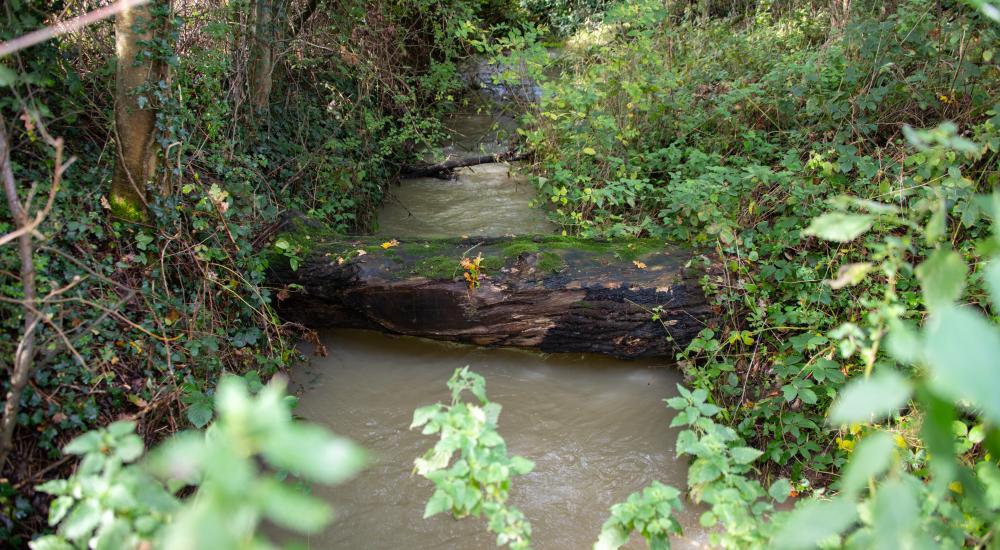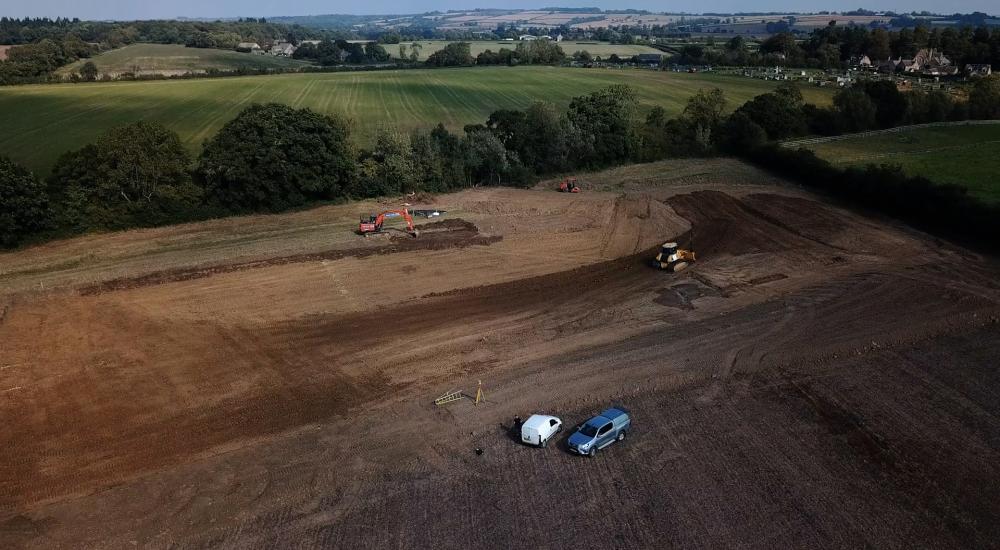NFM proves its worth in the Cotswolds
In a quiet corner of the Cotswolds, the latest techniques and a truly collaborative approach have been applied to the age‑old practice of Natural Flood Management (NFM). NFM has traditionally used low‑tech solutions, but now a ground‑breaking scheme at Littlestock Brook is helping to prove the technique’s worth, as well as maximise its impact. David Ramsbottom takes us on a journey to rural Oxfordshire to find out more.
Littlestock Brook, a tributary of the River Evenlode, flows through gentle farmland. The brook’s downstream flood plain passes through the village of Milton-under-Wychwood, problematic for local residents when the brook overflows, with a number of properties at risk of flooding. Notable floods are frequently recorded in the village, with water levels in 2007 reaching the highest ever. And, of course, the effects of climate change are unlikely to improve the situation.
Compared to national levels, the number of houses affected by flooding from Littlestock Brook is small, and an engineered flood mitigation scheme simply isn’t a justifiable solution. So, the forward-thinking Milton-under-Wychwood Parish Council approached Wild Oxfordshire, hosts of the Evenlode Catchment Partnership, and the Environment Agency (EA), to find out how a small, rural community could manage its own flood risk.
In response, the catchment partnership chose to implement a progressive NFM scheme. NFM uses a variety of measures to reduce flood risk including: using landscaped earthworks to store water in the floodplains or in the catchment; increasing infiltration of rainfall into the ground; increasing evapotranspiration by planting trees; slowing the runoff in the catchment using vegetation or hedgerows; and slowing water discharge into rivers and floodplains by creating dams with woody debris such as tree trunks.

In 2016, the EA secured a five-year funding package from the Thames Regional Flood & Coast Committee (RFCC) to trial a range of these NFM solutions for Littlestock Brook. The project used the Catchment Based Approach (CaBA), which involves collaboration between local communities and other partners. Increasingly popular, there are now over 100 catchments in the UK using catchment partnerships to deliver a range of environmental, social and economic benefits, and protect water environments, according to the CaBA website.
Jo Old, NFM project manager at the EA explains: “The RFCC funding was combined with Environment Agency environment and flood risk funding, as well as contributions from partners such as Thames Water and the Parish Council. We also received in-kind contributions of time and resources from many interested parties.
“Importantly, we were blessed with forward-thinking landowners, the Bruern Estate, owned by the Astor family. With all NFM projects, the power of a positive landowner relationship cannot be stressed enough. In this case, the enthusiasm and engagement of the farm manager, Matt Childs, was instrumental in delivering an effective scheme.”
For NFM schemes, supportive landowners are not only crucial because they need to agree to major works on their land, but also to ensure that NFM measures live on in the landscape well into the future. NFM needs to be integrated into agricultural businesses and, ideally, funded through associated land management schemes. In a future of ‘payment for public goods’ the services of improved water quality, flood storage, carbon capture and habitat creation could easily be delivered by landowners adopting NFM measures.
Matt Childs, farm manager at the Bruern Estate, explains what the project has helped achieve: “Getting involved in this scheme encompasses many of the values that are important to us in managing the Bruern Estate: helping the local community; improving soil and water quality; creating new habitat and increasing biodiversity. To be able to accomplish all these aims in one project highlights what can be achieved by working in partnership.”
In the project’s first year, key partners, including the Bruern Estate, the EA, Parish Council and Wild Oxfordshire, set up a tributary catchment trial for Littlestock Brook, using ‘opportunity mapping’ and site walkovers to plan and implement a suite of NFM measures. These included: creating temporary water retention ponds in field corners; constructing bunds and scrapes to store more floodwater on grassland areas; installing woody material in the brook’s channel to create leaky dams; and land management changes, including planting woodland in flood source areas and along flood pathways.
This was a great start, and Wild Oxfordshire and the EA were keen to use more technical analysis. And the timing couldn’t have been better, with HR Wallingford, the internationally renowned hydraulics organisation based in Oxfordshire, already setting out to prove the benefits of NFM, a question that has long needed an answer.
Spotting that there was very little evidence to demonstrate the actual performance of NFM, HR Wallingford wanted to see how useful NFM measures were in practice by using very detailed analysis, which could then be used to guide the design of future schemes. This is hugely advantageous as it allows those managing schemes to: quantify the impacts of NFM measures; estimate changes in flooding from schemes; and calculate savings from the reduction in flood damages.
In 2017, keen to employ its science-led approach to a real-life project, and hopefully demonstrate its success, HR Wallingford asked the EA to use Littlestock Brook as a test case. The initial work was part of HR Wallingford’s internally-funded research programme, which it uses to help solve the world’s most pressing water-related problems.
Wild Oxfordshire and the EA subsequently asked HR Wallingford to predict water flow throughout the catchment, and then, in 2019, to help develop and design NFM measures using the kind of rigorous engineering practice usually reserved for much bigger flood defence projects.
In this case, the approach for protecting the village from flooding was relatively simple – build a series of landscaped earthworks in the corners of fields to store excess rainwater and release it slowly back into the brook. However, the process for doing this was anything but straightforward.
On the modelling side, the team looked at rainfall across the catchment to map overland flow paths and identify where the field corner bunds could be built. The 2D model was extremely detailed, taking into account bridges, culverts and driveway drainage and used seven rainfall scenarios, two of which took climate change into account. An initial high-level investigation identified potential areas for NFM measures and this was followed by more detailed modelling of some of the recommended sites. The model was also able to show the benefits of reduced flow volumes in the brook to the areas around the residential properties.
Whilst other bunds had been built earlier in the project, those closest to the village were considered the most crucial and given special treatment. Working together, the catchment partnership and HR Wallingford identified various sites and then narrowed these down to two fields: New Field and Little Meadow, both located on the Bruern Estate. In 2019 the development of the two embankments was given the green light by the progressive landowner.
The team then looked at the viability of various structures for the two different fields, creating conceptual designs for mildly sloping clay bunds, before going on to develop them into detailed designs. These used a quantified and structured approach and took hydraulic, constructional and environmental considerations into account. They also looked at design criteria, such as whether there was sufficient freeboard, as well the location of overflow spillways to release surplus water, and drainage pipes for draining the areas after a flood.
Another consideration was ensuring that the volume of water stored behind each embankment was less than 10,000m3, to avoid the areas being classified as small dams under the Reservoirs Act. Small dams are subject to regular inspection requirements, causing additional complications and cost for the landowner. Using the model, HR Wallingford was able to show how much water would be stored behind the new bunds, ensuring the limit was not exceeded.

Any good engineering project has its challenges, and at Littlestock Brook there were some unexpected obstacles. For instance, the plan originally included an area of land that had historically been used for fish ponds, complete with its original embankments. These were included in the detailed designs but, in the end, the scale of engineering required was just too complex and costly.
After several iterations, the project partners agreed the final design. They then engaged White Horse Contractors to bring it to life, with construction commencing in 2020. White Horse have an enviable collection of high tech equipment and were able to use the latest site technology, including a laser guided bulldozer, which gave the bund the compaction it needed for reliable performance.

Once the digging was done, the work of creating new habitats began. There have been numerous trees planted across the site and the Bruern Estate has been sowing wildflower meadows with seeds from Glorious Cotswolds, an organisation committed creating wildflower meadows across the region.
Matt Childs from the Bruern Estate describes why the fields around the brook are ideal for this purpose: “Wildflower meadows need quite poor soil and the newly turned clay, exposed by construction of the bunds, is perfect. We sowed the seeds in February 2021 and, with good land management practices in place to stop the soil compacting, we are excited to see the new habitat develop.”
So, what does this mean for Milton-under-Wychwood? Well, the modelling shows that the new measures will reduce the number of properties flooded across a range of flooding scenarios. They also demonstrate that property damage will be reduced by about 60% for a 30-year flood, and 20% for a 100-year flood. All in all, there is a 40% reduction in flood damages, which equates to around £200,000.
But, as they say, the proof of the pudding is in the eating, and what better way to show the impact of the scheme than when heavy rainfall fell in January 2021. The wet weather brought flooding misery to many in the midst of the third English COVID lockdown, but not in Milton-under-Wychwood.
Ann Berkeley of Wild Oxfordshire explains: “Before the construction of the NFM scheme, flooding in the village would certainly have been expected, but, thankfully for the villagers, the bunds did their job and not a single house was flooded, despite plenty of other flooding in the catchment. This outcome is hugely exciting, not only for the local community, with whom we have worked so closely, but also for the future of NFM.”

Clearly, this approach comes with a price tag, so researchers hope this kind of state-of-the-art modelling will be used to develop rules for estimating the effects of NFM measures. This, in turn, can be used with relatively simple catchment modelling to assess the effects of future schemes.
Returning to site, and seeing the two fields now, it will soon be hard to believe that such large-scale earthworks took place only months before. And with the grass and wildflowers slowly returning, and the newly planted trees maturing, the gently sloping landscape will soon look like any quintessentially English rural scene. But a new chapter has been written in the field of natural flood management and the local community will see the benefits for years to come.
What’s certain is that, with flooding on the rise, managing floods naturally is going to become increasingly important for providing flow storage, carbon savings, water quality and habitat benefits. And, as NFM matures, it’s likely that the work done at Littlestock Brook will become a benchmark for future projects.
Want to know more?
